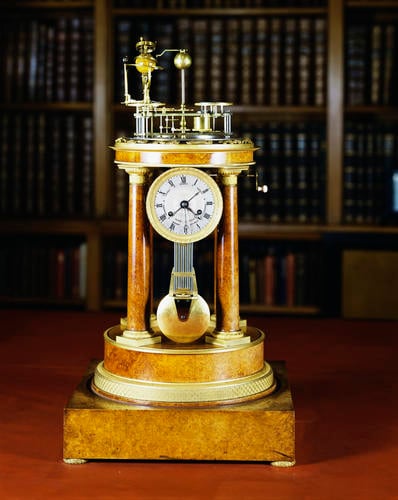Table clock c.1823-4
Amboyna, ormolu | 78.0 x 41.5 x 42.0 cm (whole object) | RCIN 30002
-
An astronomical gilt bronze and amboyna orrery and clock. Mounted on a circular base surmounted by four pillars with ormolu capitals and bases which support a circular top with the signs of the zodiac and an astronomical orrery. The gilded dial has the 12 hours represented by Roman numerals and the days of the week in an inner circle; blued steel moon hands with a stylised pointer for the days of the week. All mounted on a square plinth with cased circular ormolu feet.
The orrery makes one revolution a year and has a dial mounted over its winding square divided into 48 months and showing leap years and 1st, 2nd & 3rd common years. It revolves round a horizontal date dial with a pointer above the signs of the Zodiac annually; there is no mechanical correction for the leap years. The movement of the orrery moves around the sun and drives the earth and the moon in their correct orbits with a dial showing the age of the moon. The moon is running on its own track and is half silver and half black to represent how it looks in the night sky. The Earth has two curved pointers that denote sun rise and sun set as they occur around the world.
The clock movement is set between two of the four pillars that support the orrery above the clock. The clock movement has locking plate strike and strikes the hours on a single bell. The going train has a dead beat escapement with a grid iron compensated pendulum. In the motion work is the extra gearing to show the day of the week.
The orrery is driven by its own barrel and mainspring and is wound every four years. It is regulated by the clock below by a set of gears running up from the clock to control the orrery. There is a turning handle with gearing on the other end of its arbour that can be used to correct the orrery's position or show its functions. Pictoral Inventory RCIN 934763
An almost identical clock is in the Science Museum, London.Provenance
Purchased by George IV in 1824 for 300 guineas from the inventor, Raingo of Paris. It was originally placed in the Armoury at Carlton House.
Included in the Pictorial Inventory of 1827-33 – RCIN 934760. The inventory was originally created as a record of the clocks, vases, candelabra and other miscellaneous items from Carlton House, as well as selected items from the stores at Buckingham House, the Royal Pavilion, Brighton, Hampton Court and Kensington Palace for consideration in the refurbishment of Windsor Castle.
Raingo had premises in Paris in rue de Cléry, rue Vielle du Temple and from 1840-50 in the rue de Saintonge. It is known that Raingo produced six of these clocks and it is suggested that the original model was designed by Percier and Fontain for the Emperor Napoleon either at the Tuilleries or Malmaison. It is thought that Raingo visited England during the Peace of Amiens in 1802 and sold five or six of the clocks to the then Prince of Wales who, it is understood, gave one each to his brothers the Dukes of York, Cumberland, Kent, Sussex and Gloucester. -
Creator(s)
(clockmaker)(nationality)Acquirer(s)
-
Medium and techniques
Amboyna, ormolu
Measurements
78.0 x 41.5 x 42.0 cm (whole object)
Alternative title(s)
Orrery clock
Place of Production
Paris [Île-de-France]










